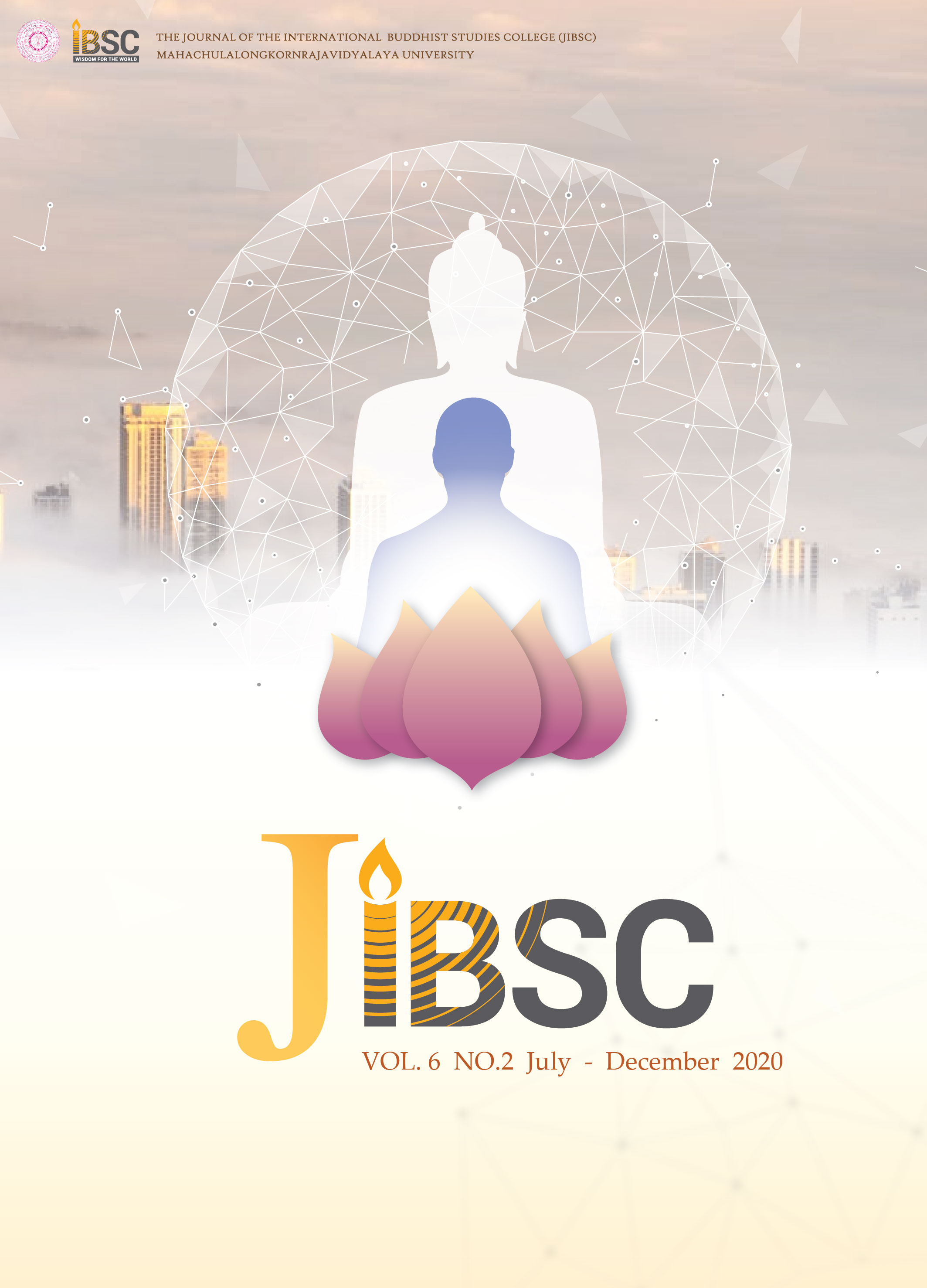Development of the Concept of an Arahat in Theravāda Buddhism Arahat in Theravada Buddhism
Main Article Content
Abstract
This paper explores the development of the concept of an Arahat, its characteristics and qualities in Theravāda school of Buddhism. One who eradicated of all cankers (āsavā) such as desire for sensual pleasure (kāmāsava), desire for becoming (bhavāsava), and ignorance (avijjāsava) attained arahatship. A person who has reached the fourth and the highest stage of enlightenment, having eradication of all defilements (kilesas). In this paper discussed about the development of the concept of Arahat since pre-Buddhistic period till today. Theravāda school of Buddhism has three kinds of attainments can be reached such as Sammāsambuddhas (Supremely Enlightened Ones), Pacceka-Buddhas (Hermit Buddhas), and Arahats (Enlightened disciples) having fulfilled the ten (pārāmitā).
An Arahat also known as ‘sāvaka’ in Theravāda Buddhism. In Theravāda Buddhist tradition, one can become a Buddha, a Pacceka-Buddha, or an Arahat which based on to their wishes. Having fulfilled the ten perfections (pārāmitā) for one time, he become an Arahat. It is a gradual and systematic spiritual development for every individual endowment and clearly understands the way to the destruction of cankers (āsavas) and attain the highest bliss (nibbāna).
Article Details
The Journal of TCI is licensed under a Creative Commons Attribution-NonCommercial-NoDerivatives 4.0 International (CC BY-NC-ND 4.0) licence unless otherwise stated. Please read our Policies page for more information on Open Access, copyright and permissions.
References
1.1 Text and Translations
Andersen, Dines and Smith, Helmer. 1913. Sutta Nipāta. London: Pāli Text Society.
Ācharya Buddharakkhita. 1985. The Path of Wisdom (Dhammapada). Kandy:
Buddhist Publications Society.
Bhikkhu Bodhi. 2012. The Gradual Sayings of the Buddha (Aṅguttaranikāya).
Boston: Wisdom Publications.
___________. 2005. In the Buddha’s Words: An Anthology of Discourses from the
Pāli Canon. Boston: Wisdom Publications.
___________. 2000. The Connected Discourses of the Buddha (Saṁyuttanikāya).
Vol. I. Boston: Wisdom Publications.
Bhikkhu Ñāṇamoli and Bhikkhu Bodhi. 1995. The Middle Length Discourses of the
Buddha (Majjhimanikāya). Somerville: Wisdom Publications.
Bhikkhu Ñāṇamoli. 1982. Paṭisambhidāmagga. London: Pāli Text Society.
Buddhaghosa. 2010. Bhikkhu Ñāṇamoli. The Path of Purification (Visuddhimagga).
Kandy: Buddhist Publications Society.
Hare, E.M. 1965. The Book of the Gradual Sayings (Aṅguttaranikāya). Vol. IV.
Oxford: Pāli Text Society.
Horner, I.B. 2000. The Collection of the Middle Length Sayings (Majjhimanikāya).
Vol. I. Oxford: Pāli Text Society.
Norman, K.R. 1995. The Elders’ Verses I (Theragāthā). Oxford: Pāli Text Society.
Paṭhamakyaw Ashin Thiṭṭila (Seṭṭhila). 1995. The Book of Analysis (Vibhaṅga).
Oxford: Pāli Text Society.
Rhys Davids, T.W. 1881. The Sacred Books of the East. Various Scholars and ed. F.
Max Muller. Vol. XI. Oxford: The Clarendon Press.
___________. 1973. The Book of the Gradual Sayings (Aṅguttaranikāya). Vol. III.
Oxford: Pāli Text Society.
Upatissa, Arahant. 1961. Vimuttimagga. From Chinese by Rev. N.RM. Ehara Soma
Thera and Kheminda Thera. Ceylon: Foreword by Buddhist Publications Society. Published by Dr. D. Roland D. Weerasuria.
Walshe, Maurice. 1987. Dīghanikāya. Boston: Wisdom Publications.
Woodward, F.L. 1970. The Book of the Gradual Sayings (Aṅguttaranikāya). Vol. I.
Oxford: Pāli Text Society.
____________. 1973. The Book of the Gradual Sayings (Aṅguttaranikāya). Vol.
II. Oxford: Pāli Text Society.
2. Secondary Sources:
Akira, Hirakawa. 1990. A History of Indian Buddhism From Sākyamuni to Early
Mahāyāna. Hawaii: University of Hawaii Press.
Buddhadatta, Mahāthera, A.P. 2008. Concise Pāli-English Dictionary. 2nd ed.
Ceylon: University of Ceylon.
Buddhadasa. 2005. Handbook for Mankind. Bangkok: Thammasapa Press.
Buswell, E. Robert. 2004. Encyclopedia of Buddhism. Vol.1. New York: Macmillan
Reference.
Bapat, P.V. 1956. 2500 Years of Buddhism. Foreword by S. Radhakrishnan. Delhi: The
Publications Division.
___________. 1937. Vimuttimagga and Visuddhimagga - A Comparative Study.
Poona: Department of Sanskrit, University of Poona.
___________. 1980. The Questions of King Milinda (Milinda Paṇha). Vol. XXXV.
Oxford: Clarendon Press.
Endo, Toshiichi. 2002. Buddha in Theravāda Buddhism. Dehiwela: Buddhist
Cultural Centre.
Hamilton, L. William. 1995. Saints and Psychopaths Part II. San Jacinto California:
Dharma Audio Network Associates.
Horner, I.B. 1936. Early Buddhist Theory of Man Perfected: A Study of the
Arahan. London: William and Norgate Ltd.
Irons, A. Edward. 2008. Encyclopedia of Buddhism. Series ed. by J. Gordon Melton.
New York: Facts On File, Inc.
Katz, Nathan. 1989. Buddhist Images of Human Perfection: The Arahant of the
Sutta Piṭaka Compared with the Bodhisattva and the Mahāsiddha. Delhi: Motilal Banarsidass.
Kalupahana, J. David. 1999. The Buddha's Philosophy of Language. Lumbini
Mawatha Ratmalana: A Sarvodaya Vishva Lekha Publication.
Nyanatiloka. 1980. Buddhist Dictionary. 4th ed. Kandy: Buddhist Publications
Society.
Rhys Davids, T.W.1921. Pāli-English Dictionary. London: Pāli Text Society.
Warder, A.K. 2000. Indian Buddhism. Delhi: Motilal Banarsidas.
Williams, Paul with Tribe, Anthony. 2000. Buddhist Thought: A Complete
Introduction to the Indian Tradition. New York: Routledge.


